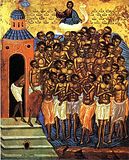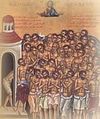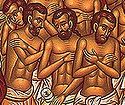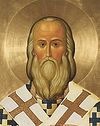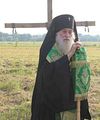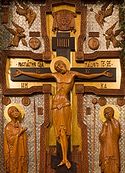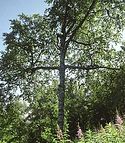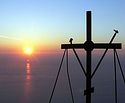

| Previous day | Next day |
| Old Style
March 9
|
Sunday |
New Style
March 22
|
|
Third Sunday of Great Lent. Adoration of the Holy Cross.
Tone 7.
Great Lent. |
Wine and oil allowed.
|
![]() The Holy Forty Martyrs of Sebaste: Cyrion (or Quirio), Candidus, Domnus, Hesychius, Heraclius, Smaragdus, Eunoicus, Valens, Vivianus, Claudius, Priscus, Theodulus, Eutychius, John, Xanthias, Helianus, Sisinius, Angus, Aetius, Flavius, Acacius, Ecdicius, Lysimachus, Alexander, Elias, Gorgonius, Theophilus, Dometian, Gaius, Leontius, Athanasius, Cyril, Sacerdon, Nicholas, Valerius, Philoctimon, Severian, Chudion, Aglaius, and Meliton (ca. 320).
The Holy Forty Martyrs of Sebaste: Cyrion (or Quirio), Candidus, Domnus, Hesychius, Heraclius, Smaragdus, Eunoicus, Valens, Vivianus, Claudius, Priscus, Theodulus, Eutychius, John, Xanthias, Helianus, Sisinius, Angus, Aetius, Flavius, Acacius, Ecdicius, Lysimachus, Alexander, Elias, Gorgonius, Theophilus, Dometian, Gaius, Leontius, Athanasius, Cyril, Sacerdon, Nicholas, Valerius, Philoctimon, Severian, Chudion, Aglaius, and Meliton (ca. 320).
Martyr Urpasianus of Nicomedia (ca. 295). St. Caesarius, brother of St. Gregory the Theologian (ca. 369). St. Tarasius the Wonderworker, of Lycaonia. Translation to Vladimir of the relics of Martyr Abraham of the Bulgars on the Volga (1230). St. Jonah, archbishop of Novgorod (1470). St. Theodosius Levitsky, priest, of Balta (Odessa) (1845). St. Dimitra, nun and foundress of the Vvedensk Convent in Kiev (1878).
New Hieromartyrs Mitrophan Buchnoff, archpriest, of Voronezh (1931), and Ioasaph (Shakhov), abbot, of Popovka (Moscow) (1938). New Hieromartyrs Sergius Lebedev, Sergius Tsvetkov, and Alexis Smirnov, archpriests, and Dimitry Glivenko, priest, all of the Moscow region (1938).
“Albazin” Icon of the Most Holy Theotokos (“The Word Was Made Flesh”) (1666).
St. Philoromus the Confessor, of Galatia (4th c.). St. Pacianus, bishop of Barcelona (390). St. Bosa, bishop of York (705). St. Vitalis of Castronovo (994). New Martyrs (two priests and forty students) of Momisici (Montenegro) (1688).
Repose of Elder Cleopas of Ostrov-Vvedensk Monastery (1778) and Schema-archimandrite Theophilus of Kiev (1996).
Thoughts for Each Day of the Year
According to the Daily Church Readings from the Word of God
By St. Theophan the Recluse

Third Sunday of Lent. [Heb. 4:14–5:6; Mark 8:34–9:1]
Whosoever will come after me, let him deny himself, and take up his cross, and follow me (Mark 8:34). It is impossible to follow the Lord as a crossbearer without a cross, and everyone who follows Him, unfailingly goes with a cross. What is this cross? It is all sorts of inconveniences, burdens and sorrows—weighing heavily both internally and externally—along the path of conscientious fulfilment of the commandments of the Lord, in a life according to the spirit of His instructions and demands. Such a cross is so much a part of a Christian that wherever there is a Christian, there is this cross, and where there is no such cross, there is no Christian. Abundant privileges and a life of pleasure do not suit a true Christian. His task is to cleanse and reform himself. He is like a sick person, who needs cauterization, or amputation; how can this be without pain? He wants to tear himself away from the captivity of a strong enemy; but how can this be without struggle and wounds? He must walk counter to all practices surrounding him; but how can he sustain this without inconvenience and constraint? Rejoice as you feel the cross upon yourself, for it is a sign that you are following the Lord on the path of salvation which leads to heaven. Endure a bit. The end is just around the corner, as well as the crowns!
Articles
 Martyr Urpasianus of NicomediaThe Holy Martyr Urpasianus suffered in the city of Nicomedia. |
 St. Caesarius, brother of St. Gregory the TheologianSaint Caesarius lived for a long time at the court of the emperor Constantius (337-361), and was his friend and chief court physician. |
 Icon of the Mother of God “The Word was made Flesh”The Albazin Icon of the Mother of God “the Word made Flesh” is of great religious significance in the Amur River region. |
